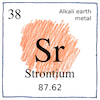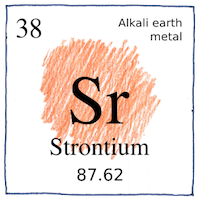London—Adair Crawford,
William Cruikshank,
Humphry Davy
elements

|
Strontium
Between 1787 and 1790 the Scottish surgeon and chemist William Cruikshank and the Irish physician and chemist Adair Crawford found that the Scottish mineral from lead mines near the Scottish village Strontian contained a new earth, distinct from barium. * In 1791 the German physicans Friedrich Gabriel Sulzer and Johann Friedrich Blumenbach published a paper that reported their experiments with the mineral. They named the mineral strontianite. * Between 1791 and 1793, Thomas Charles Hope, Scottish physician and chemist in Edinburgh, repeated Cruikshank and Crawford’s experiments and named the element strontites. * Meanwhile, in 1793 and 1794, the German chemist Martin Heinrich Klaproth and the Irish scientist Richard Kirwan independently experimented with the mineral and prepared various compounds of the element. * In 1808, Humphry Davy isolated the element “by the electrolysis of a mixture containing strontium chloride and mercuric oxide.” Davy named the element strontium following the naming principle of other alkaline earths—calcium, barium, magnium.*
Atomic number 38
Strontium oxide and barium oxide in the glass of cathode-ray tubes absorbs X-rays. * The proportions of isotopes of strontium absorbed like calcium in bones identifies geographical origins. * In fireworks and flares, strontium salts such as strontium carbonate and strontium chloride burn deep red. * Radioactive strontium-89 in the treatment of bone cancer reduces metastatic bone cancer. * Radioactive strontium-90 in radioisotope thermoelectric generators is a power source. * Strontium chloride in toothpaste fills holes in dentin to make teeth less sensitive.
Minerals
The chemistry of the earth creates compounds strange and beautiful, crystaline, transparent, translucent, and luminescent in veins, geodes, and concretions. Many attractions, many combinations. It took many years to unravel the minerals to find the elements that never appear alone in nature.



*Magnium was Davy’s preference for naming magnesium.
In the seventeenth century, we saw alchemists performing experiments with minerals; in these centuries we see physicians and chemists doing the same work, but with less mysticism.
See also in The book of science:
Readings in wikipedia:
Other readings: